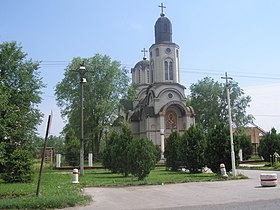Crvenka
Crvenka
Црвенка(Serbian) | |
|---|---|
| Crvenka | |
 | |
| Coordinates:45°39′30″N19°27′20″E/ 45.65833°N 19.45556°E | |
| Country | |
| Province | |
| Region | Bačka |
| District | West Bačka |
| Municipality | Kula |
| Establishment | Inhabited during the earlyNeolithic |
| Government | |
| •Mayor | Hortik Peča |
| Elevation | 86 m (282 ft) |
| Population (2011) | |
| • Total | |
| • Density | 142/km2(370/sq mi) |
| Time zone | UTC+1(CET) |
| • Summer (DST) | UTC+2(CEST) |
| Postal code | 25220 |
| Area code | (+381) 25 |
| Car plates | SO |




Crvenka(Serbian Cyrillic:Црвенка) is a small town located in the municipality ofKulain theWest Bačka District,Autonomous Province ofVojvodina,Serbia.The town has aSerbianethnic majority, and it had a population of 9,001 in 2011.
Name
[edit]InSerbian,the town is known as Crvenka (Црвенка), inHungarianasCservenka,and inGermanasTscherwenkaorRotweil.The name of the town is derived from the Serbian wordcrveno'red'.
History
[edit]In prehistoric times, the region around Crvenka was covered by water because between theDanubeRiver and Telečka Plateauthere was a large lake, which was described byRoman historiansas "Sweet Lake." At that time it was possible to travel by boat to theFruška Goramountains. In the city remains of prehistoric animals have been found, such as themammoth.The region was most likely inhabited during the earlyNeolithic,when the region belonged to theStarčevo culture.Later theCeltssettled in the area around Crvenka.
In the immediate vicinity, archaeological excavations have found objects from Celtic and Roman times, includingurnsandpottery,as well asCelticandRoman coins.The Roman coins, known asFollis,depict Roman EmperorConstantine the Great,and some others originated from theRepublic of Venice.From the middle of the 1st century to the 4th century, the region belonged to the dominion of theIazyges,a nomadic tribe that belonged to theSarmatians.Starting in the 5th century,Slavssettled in the region, and from the 9th century onward alsoHungarians.[citation needed]
Crvenka was firstly mentioned in historical sources in the 16th century, duringOttomanadministration. It was populated by ethnicSerbsand was part of theSanjak of Segedinand of theBudin Eyalet.In the second half of the 17th century, this area was not populated.
At the end of the 17th century, theBačkaregion was captured by theHabsburg monarchy,and in the second half of the 18th century Crvenka was mentioned as a small settlement. It was colonized bySerbs,Hungarians,andGermans.Until the middle of the 19th century, the town was part ofBács-Bodrog Countywithin theHabsburg Kingdom of Hungary.In 1848–1849 it was part of the autonomousSerbian Vojvodina,and from 1849 to 1860 it was part of theVoivodeship of Serbia and Banat of Temeschwar,a separate Habsburg crownland. After the abolition of the voivodeship in 1860, the town was again included inBács-Bodrog County.According to 1910 census, most of the inhabitants of the town spokeGerman.
After 1918, the town was part of theKingdom of Serbs, Croats and Slovenes(later renamedYugoslavia). In 1918–1919, it was part of theBanat, Bačka and Baranjaregion, and also (from 1918 to 1922) part ofNovi SadCounty. From 1922 to 1929, it was part of theBačkaOblast, and from 1929 to 1941 part of theDanube Banovina.
From 1941 to 1944, Crvenka was underAxisoccupation and was attached to theHorthy'sHungary.In 1944, theSovietRed ArmyandYugoslav Partisansliberated Crvenka and it was included in the autonomous province ofVojvodinawithin the newcommunist Yugoslavia.After 1945, Vojvodina was part of thePeople's Republic of Serbiawithin Yugoslavia. At the end ofWorld War II,the ethnicGermanpopulation was expelled from Crvenka, which was then populated by 4,383 people, mostlySerbs of Bosnia and HerzegovinaandMontenegro.In 1948, these people comprised 63.7% of the population.
Demographics
[edit]Ethnic groups
[edit]In 2002 the population of Crvenka was 10,163 people, including:
- Serbs= 7,264 (71.48%)
- Montenegrins= 1,313 (12.92%)
- Hungarians= 493 (4.85%)
- Croats= 183 (1.8%)
- Yugoslavs= 156 (1.54%)
- others (includingUkrainians,Pannonian Rusyns,Germans,Romani people,etc.)
Historical population
[edit]- 1948: 6,879
- 1953: 7,797
- 1961: 9,369
- 1971: 10,098
- 1981: 10,629
- 1991: 10,409
- 2002: 10,315
- 2011: 9,001
Economy
[edit]Crvenka is a small town with a very strong economy, especially industry and agriculture.
The most important companies in Crvenka include:
- The Crvenka Sugar Factory (Crvenka Fabrika Šećera a.d. / EBZ)[1]
- TheJaffa Biscuit Company[2]
- The Panon AD Alcohol and Beverage Factory[3]
- FSH Crvenka AD
- Jedinstvo IGM Crvenka[4]
- SIGMA d.o.o
- ALTER EGO d.o.o[5]
- DP Zaliv d.o.o.[6]
- ZZ Novo
- BXB d.o.o
- Permak d.o.o[7]
- KUĆA HEMIJE MARIVA d.o.o.
Sport
[edit]Crvenka has a handball club namedRK Crvenka.There is also a football team,FK Crvenka,with a long tradition. Crvenka has a chess club namedŠK Miljo Vujovićand akarateclub.
Notable residents
[edit]- Milorad Vučelićformer vice-president of theSocialist Party of Serbiaand close associate ofSlobodan Milošević.
- Ratko Svilar,former football goalkeeper who participated in the1982 FIFA World Cup.
- Zorica Vojinović,former handball player who competed in the1980 Summer Olympics.
See also
[edit]Gallery
[edit]-
Railway
-
Railway Station
-
Bus Station
-
Town Center
Notes
[edit]- ^""CRVENKA" Sugar Factory a.d. Crvenka ".
- ^"Jaffa - Fabrika biskvita Jaffa DOO".
- ^"PANON A.D. Crvenka - Alcohol, vinegar and yeast factory".Archived fromthe originalon 28 March 2012.Retrieved4 August2011.
- ^"JEDINSTVO I.G.M. Crvenka".Archived fromthe originalon 28 March 2012.Retrieved4 August2011.
- ^"Home".alterego.rs.
- ^"< DP Zaliv d.o.o. > Domaci i medjunarodni transport i promet robe".Archived fromthe originalon 21 May 2009.
- ^"Home".permark.rs.
References
[edit]- Slobodan Ćurčić, Broj stanovnika Vojvodine, Novi Sad, 1996.
- Slobodan Ćurčić, Naselja Bačke - geografske karakteristike, Novi Sad, 2007.








